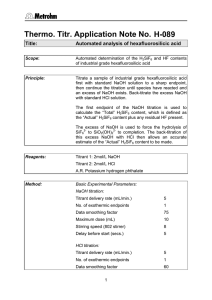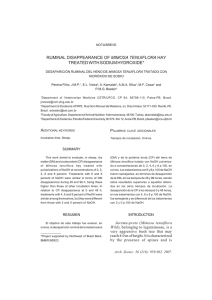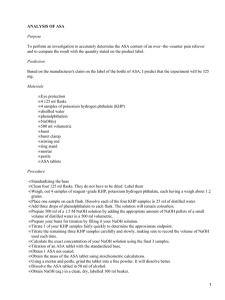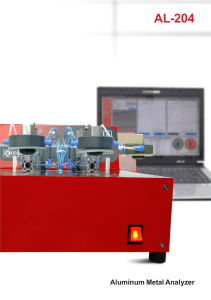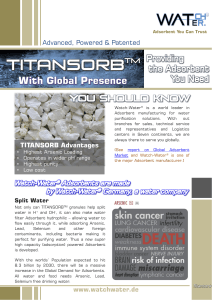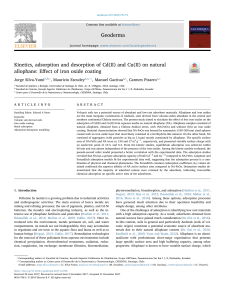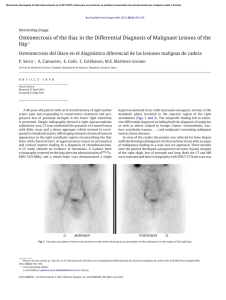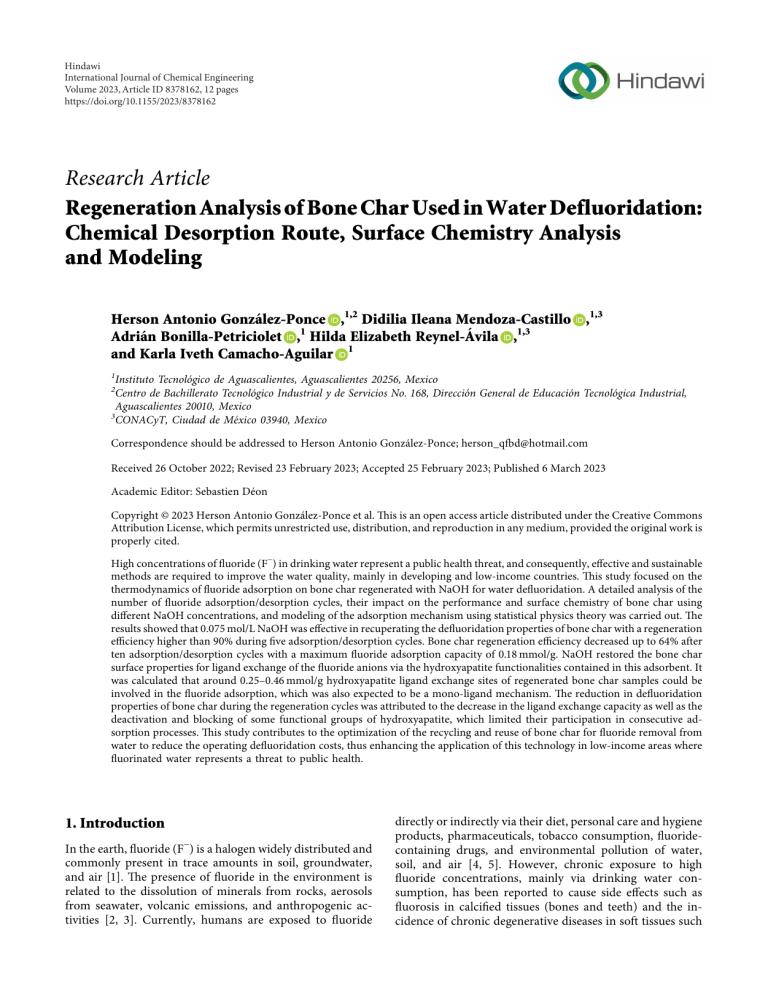
Hindawi International Journal of Chemical Engineering Volume 2023, Article ID 8378162, 12 pages https://doi.org/10.1155/2023/8378162 Research Article Regeneration Analysis of Bone Char Used in Water Defluoridation: Chemical Desorption Route, Surface Chemistry Analysis and Modeling Herson Antonio González-Ponce ,1,2 Didilia Ileana Mendoza-Castillo ,1,3 Adrián Bonilla-Petriciolet ,1 Hilda Elizabeth Reynel-Ávila ,1,3 and Karla Iveth Camacho-Aguilar 1 1 Instituto Tecnológico de Aguascalientes, Aguascalientes 20256, Mexico Centro de Bachillerato Tecnológico Industrial y de Servicios No. 168, Dirección General de Educación Tecnológica Industrial, Aguascalientes 20010, Mexico 3 CONACyT, Ciudad de México 03940, Mexico 2 Correspondence should be addressed to Herson Antonio González-Ponce; herson_qfbd@hotmail.com Received 26 October 2022; Revised 23 February 2023; Accepted 25 February 2023; Published 6 March 2023 Academic Editor: Sebastien Déon Copyright © 2023 Herson Antonio González-Ponce et al. Tis is an open access article distributed under the Creative Commons Attribution License, which permits unrestricted use, distribution, and reproduction in any medium, provided the original work is properly cited. High concentrations of fuoride (F−) in drinking water represent a public health threat, and consequently, efective and sustainable methods are required to improve the water quality, mainly in developing and low-income countries. Tis study focused on the thermodynamics of fuoride adsorption on bone char regenerated with NaOH for water defuoridation. A detailed analysis of the number of fuoride adsorption/desorption cycles, their impact on the performance and surface chemistry of bone char using diferent NaOH concentrations, and modeling of the adsorption mechanism using statistical physics theory was carried out. Te results showed that 0.075 mol/L NaOH was efective in recuperating the defuoridation properties of bone char with a regeneration efciency higher than 90% during fve adsorption/desorption cycles. Bone char regeneration efciency decreased up to 64% after ten adsorption/desorption cycles with a maximum fuoride adsorption capacity of 0.18 mmol/g. NaOH restored the bone char surface properties for ligand exchange of the fuoride anions via the hydroxyapatite functionalities contained in this adsorbent. It was calculated that around 0.25–0.46 mmol/g hydroxyapatite ligand exchange sites of regenerated bone char samples could be involved in the fuoride adsorption, which was also expected to be a mono-ligand mechanism. Te reduction in defuoridation properties of bone char during the regeneration cycles was attributed to the decrease in the ligand exchange capacity as well as the deactivation and blocking of some functional groups of hydroxyapatite, which limited their participation in consecutive adsorption processes. Tis study contributes to the optimization of the recycling and reuse of bone char for fuoride removal from water to reduce the operating defuoridation costs, thus enhancing the application of this technology in low-income areas where fuorinated water represents a threat to public health. 1. Introduction In the earth, fuoride (F−) is a halogen widely distributed and commonly present in trace amounts in soil, groundwater, and air [1]. Te presence of fuoride in the environment is related to the dissolution of minerals from rocks, aerosols from seawater, volcanic emissions, and anthropogenic activities [2, 3]. Currently, humans are exposed to fuoride directly or indirectly via their diet, personal care and hygiene products, pharmaceuticals, tobacco consumption, fuoridecontaining drugs, and environmental pollution of water, soil, and air [4, 5]. However, chronic exposure to high fuoride concentrations, mainly via drinking water consumption, has been reported to cause side efects such as fuorosis in calcifed tissues (bones and teeth) and the incidence of chronic degenerative diseases in soft tissues such 2 as liver, kidneys, heart, and central nervous system [5]. Te incidence of fuoride-related diseases in populations from diferent countries has increased in recent decades owing to the difculty in accessing clean and purifed drinking water in developing countries [6]. Terefore, the World Health Organization (WHO) has established a guideline value of fuoride in drinking water at a maximum of 1.5 mg/L to minimize fuoride exposure toxicity [7]. Tere are diferent techniques to remove fuoride from aqueous solutions and reduce the exposure of the population to this toxic water pollutant; however, not all alternatives are optimal due to their cost-efectiveness and environmental impact. Te selection of the best technology for the removal of specifc target pollutants relies on selectivity, costefectiveness, energy consumption, and environmental impact. Adsorption is a viable and reliable technology for wastewater and groundwater treatment and purifcation. Tis process is fexible, versatile, requires low energy, and can be applied in real life for water sanitation [8]. Activated carbon is a universal adsorbent that is used for the removal of organic and inorganic water pollutants [9]. Novel adsorbents have been introduced to remove diferent water pollutants, and special attention has been paid to tailoring their surface functionalities and textural parameters [10–12]. However, there is a growing interest in the use of alternative adsorbents for water treatment that can be prepared from agricultural by-products and nontraditional biomass [13–18]. Tese alternative adsorbents are characterized by their low cost, competitive adsorption capacity, and reduced environmental pollution. On the other hand, the reduction, recycling, and correct disposal of municipal solid wastes also represent an important improvement in environmental quality that clearly contributes to human health protection. It has been estimated that solid waste generation in 2025 will be approximately 2.2 billion tons, which could be linked to serious health problems around the world [19]. A signifcant amount of solid waste in industrialized countries is generated by food, with ∼222 million tons globally [20]. Only in the U.S., the total food waste disposed per year was estimated at 35.5 million tons in 2015 [21]. Te amount of food waste, including meat and bone residues, continues to increase annually. It is estimated that they will increase globally in the next decade by 16% for beef and veal meat, 21% for sheep meat, 18% for poultry, and 11% for pig meat [22]. Te disposal of bone residues also represents a human health problem due to the presence of pathogens. Alternatives to reduce and recycle these bone wastes are required to minimize environmental impact and population health risks. Te application of pyrolysis of bone waste ofers the possibility of generating value-added products such as bone char [23]. Bone char (BC) is considered an eco-friendly material because of its low-cost, biocompatibility, and contribution to the sustainable recycling of bone wastes [24]. Te major component of BC is hydroxyapatite, which accounts for approximately 70–80% of its total content. Te composition of calcium hydroxyapatite makes it an interesting material for biological and chemical processes due to its ion exchange International Journal of Chemical Engineering properties [25, 26]. BC has also been recognized as the best commercial adsorbent already available in diferent countries for facing water defuoridation. After the use of BC for fuoride adsorption, it is important to recycle and dispose of it properly. Despite the benefts of BC production, its life cycle and regeneration chemistry as an adsorbent for fuoride removal have not been analyzed in detail. To date, thermal and chemical-based methods for BC regeneration have been tested and reported [27–29]. Chemical regeneration is a common approach for the desorption of pollutants from adsorbent surfaces and is characterized by its low energy requirement and high regeneration efciency [30]. Te results of some studies have shown that the chemical regeneration with sodium hydroxide (NaOH) ofers additional advantages in terms of energy consumption and process efcacy to recover the defuoridation properties of this adsorbent. Consequently, the analysis and optimization of BC regeneration with NaOH are fundamental for reducing the operating costs of fuoride removal and developing efective methods for water treatment. Te aim of this study was to analyze the thermodynamics and surface chemistry of the regeneration of BC used in water defuoridation. Tis information is relevant to improve the application of this adsorbent as an efective separation medium to reduce the fuoride concentrations in polluted drinking water, thus generating its corresponding benefts in terms of human health and environmental protection. A detailed analysis of the number of cycles in that BC can be regenerated and reused for fuoride removal is reported. BC regeneration was carried out with NaOH, and a detailed physicochemical characterization of the reused adsorbent was also performed. Teoretical calculations from statistical physics were employed to understand the impact of NaOH regeneration on the adsorbent surface chemistry. 2. Methodology 2.1. Materials and Reagents. Commercial BC was obtained from Bonechar Carvão Ativado , Paraná, Brazil. Sodium hydroxide (NaOH) was purchased from Karal , Mexico. Sodium fuoride (NaF) was purchased from J. T. Baker , Mexico, while the fuoride adjustment bufer powder pillows were obtained from Hach , USA. Deionized water was used in all experiments. ® ® ® ® 2.2. Fluoride Adsorption and Desorption Studies Using BC. Te adsorption and desorption of fuoride on BC were analyzed under batch operating conditions. Fluoride desorption kinetics and adsorption isotherms of regenerated BC were quantifed. First, BC samples were saturated with fuoride solutions of diferent initial concentrations ([F−]i), ranging from 1 to 13 mmol/L, at pH 7 and 30°C using a water bath under continuous stirring (120 rpm) for 48 h with a ratio of 2 g of adsorbent (m) per 1 L of fuoride solution (V). Preliminary studies confrmed that this operating time was sufcient to reach the adsorption equilibrium and to achieve the adsorbent saturation. Te maximum adsorption capacities of BC after diferent International Journal of Chemical Engineering 3 regeneration cycles were obtained from these isotherms. Fluoride adsorption capacities (q, mmol/g) of raw and regenerated BC samples were determined with the corresponding material balance. − − [F ]i − [F ]e q � ∙V, m (1) where [F−]e is the equilibrium fuoride concentration in the aqueous solution (mmol/L). In the second stage, BC samples saturated with the highest fuoride concentration were used in desorption studies. Fluoride desorption kinetics were carried out with NaOH concentrations of 0.01, 0.05, and 0.075 mol/L. Tese desorption studies were performed in a water bath at 30°C under continuous stirring (120 rpm) with 2 g of fuoridesaturated BC per 1 L of NaOH solution. Te fuoride concentration profle in the NaOH solution due to the desorption was monitored for 48 h. BC regenerated with NaOH was washed with deionized water, dried, and used in the next adsorption cycle to determine the corresponding adsorption isotherm and quantify its maximum adsorption capacity after regeneration. Ten fuoride adsorptiondesorption cycles were performed to analyze the defuoridation properties and surface chemistry of the regenerated adsorbent. Te desorption efciency (DE, %) and regeneration efciency (RE, %) were calculated to study and compare the fuoride adsorption properties of regenerated BC samples after diferent adsorption/desorption cycles under the same operating conditions. DE and RE were calculated with the equations [30] DE � mF,NaOH ∙100, mF,BC (2) qreg RE � ∙100, qraw where mF,BC (mmol) is the amount of fuoride adsorbed on BC before the NaOH regeneration, mF,NaOH (mmol) is the amount of fuoride desorbed with NaOH during the regeneration step, qreg is the fuoride adsorption capacity (mmol/g) of the regenerated BC at diferent adsorptiondesorption cycles, and qraw is the fuoride adsorption capacity of raw BC (mmol/g), respectively. Te fuoride concentrations in the aqueous solutions obtained from the adsorption and regeneration experiments were quantifed using a selective electrode. Fluoride quantifcation was performed at 30°C with a bufered solution via powder pillows following the method reported by Rojas-Mayorga et al. [31]. Standard curves were obtained with fuoride solutions where a logarithmic curve (log10) was employed to obtain a linear regression of millivolts (mV) versus fuoride concentration with R2 > 0.9. One-way ANOVA with a multiple comparison post-test (Tukey) and a confdence level of 95% was performed for the data analysis using the software GraphPad Prism 8. 2.3. Surface Chemistry Characterization of Regenerated BC. Fourier transform infrared (FTIR) spectroscopy was used to characterize the surface functional groups of raw and regenerated adsorbent samples. KBr powder and BC were mixed and pressed to form the KBr pellets, which were analyzed in the wavenumber range of 400–4000 cm−1 at room temperature with a resolution of 4 cm−1 using a Nicolet iS10 FTIR Termo Scientifc spectrometer. X-ray difraction (XRD) patterns were recorded to assess the crystallographic changes on the surface of regenerated BC. An Empyrean X-ray difractometer was employed in the sample analysis, which was carried out at room temperature with a PIXcel1D-Medipix3 detector and CuKα radiation (λ = 1.5406 Å, 45 kV, 40 mA) in the angle range from 20 to 70° 2θ. Te amounts of calcium and phosphate oxides in BC samples were quantifed via X-ray fuorescence, and these compositions were correlated with possible structural changes in the regenerated adsorbent. Tis determination was carried out by preparing glass disks by lithium borate fusion and using a 3-kW sequential XRF spectrometer Zetium Panalytical in a vacuum system with Ar/CH4 fow. N2 adsorption-desorption at −196.15°C was utilized to determine the textural properties (BET surface area, pore volume, and size) of the regenerated BC samples where an ASAP 2020 Micrometrics instrument was used. Morphological characteristics and elemental composition of raw and regenerated BC were studied by SEM/EDX analysis performed with a Hitachi (TM3000) scanning electron microscope and an energy dispersion system (Nano XFlash) coupled with SEM, respectively. 2.4. Calculation of Physicochemical Parameters of Fluoride Adsorption on Regenerated BC. A monolayer adsorption model based on statistical physics [32] was used to calculate the steric physicochemical parameters of fuoride adsorption on regenerated BC. Tis model is defned as follows: q� nF DBC n , 1 + [F− ]1/2 /[F− ]e F (3) where nF is the steric parameter associated with the number of fuoride ions adsorbed per binding site of BC, DBC (mmol/g) is the concentration of functional groups on BC surface involved in the fuoride adsorption, and [F−]1/2 (mmol/L) is the fuoride concentration at the half saturation. Te parameters of this adsorption model were calculated from the correlation of adsorption isotherms of the raw and regenerated bone char samples. A simultaneous nonlinear regression of all experimental adsorption isotherms was performed using an artifcial neural network to calculate the best model parameters following the procedure reported by Rodrı́guez–Romero et al. [33]. A feed-forward artifcial neural network with one hidden layer and one hidden neuron was employed in data modeling, where the input variables were the fuoride equilibrium concentrations and the number of regeneration cycles, while the output variables were the parameters of this statistical physics model, as shown in Figure 1(a). Tis data modeling was applied to the results for each NaOH concentration. Fluoride desorption 4 International Journal of Chemical Engineering Artificial neural network Equilibrium concentration . . Number of regeneration cycle . . . . Statistical physics parameters Monolayer adsorption model Data fitting . (a) Artificial neural network Regeneration time NaOH concentration Number of regeneration cycles . . . . . . Fluoride concentration in NaOH used for desorption . (b) Figure 1: Illustration of ANNs-based approach to model (a) fuoride isotherms of regenerated bone char and (b) fuoride desorption kinetics in NaOH solution. kinetics were also modeled with an artifcial neural network where the input variables were the regeneration time, NaOH concentration, and the number of regeneration cycles, see Figure 1(b). 3. Results and Discussion 3.1. Defuoridation Adsorption Properties of Regenerated BC. Fluoride desorption kinetics of BC for tested NaOH concentrations are reported in Figure 2. Overall, the amount of fuoride desorbed from the BC surface increased with NaOH concentration during the regeneration. For example, the desorbed fuoride increased by 22% when the NaOH concentration changed from 0.01 to 0.05 mol/L and 9% from 0.05 to 0.075 mol/L. Tis trend was observed for all regenerated BC samples independent of the number of regeneration cycles. However, the NaOH efectiveness for the desorption of fuoride anions from the BC surface was reduced as more adsorption-desorption cycles were performed. DE of NaOH ranged from 53 to 76% and increased with respect to NaOH concentration. In particular, the fuoride desorption efciencies (DE) were 53 – 59, 65 – 70, and 69 – 76% with 0.01, 0.05, and 0.075 mol/L NaOH solutions, respectively. Tis parameter also decreased as the number of regeneration cycles increased, indicating that the NaOH was less efective for the desorption of fuoride ions from the BC surface. Tese fndings confrmed the role of NaOH concentration in the recovery of the fuoride ions from spent BC. Kinetic results also showed that 48 h was sufcient to reach the desorption equilibrium where the amount of fuoride anions desorbed from the BC surface was the maximum. Desorption studies for a wide variety of adsorbates and adsorbents have concluded that there is a minimum concentration of the desorbing chemical required to obtain an acceptable adsorbent regeneration [30]. NaOH concentration of 0.075 mol/L appears to be efective for the regeneration of BC employed in water defuoridation at tested experimental conditions. Tis NaOH concentration was signifcantly lower than that used in other regeneration studies of BC for water defuoridation, where NaOH concentrations up to 0.5 mol/L have been reported [28, 34]. Terefore, the application of this low NaOH concentration can contribute to the minimization of the regeneration costs of this adsorbent. Te modeling of fuoride desorption kinetics with the artifcial neural network (R2 > 0.95) is reported in Figure 2. Tis surrogate model was efective in correlating the fuoride desorption profles of BC regenerated with NaOH solution. Fluoride desorption rate constants of BC were also calculated from these concentration profles using the next expression. − − − tk [F ]t,NaOH � [F ]e,NaOH 1 − exp de s , (4) where [F−]t,NaOH and [F−]e,NaOH are the fuoride concentrations (mmol/L) at time t (h) and the equilibrium of the NaOH solution during the BC regeneration, and kdes is the fuoride desorption rate constant (h−1). Calculated fuoride desorption rate constants ranged from 0.27 to 0.87 h−1. It was identifed that kdes values for fuoride desorption with 0.075 mol/L NaOH were higher than those obtained for 0.05 and 0.01 mol/ L NaOH in all regeneration cycles. Moreover, the fuoride desorption rate decreased as the number of adsorptiondesorption cycles increased. Tese results confrmed that the NaOH desorption efciency diminished as BC was regenerated several times. After each regeneration cycle, the BC surface functionalities lost their ability to interact with and bind to fuoride ions during the adsorption. Fluoride adsorption isotherms for raw and regenerated BC samples with diferent NaOH concentrations are reported in Figure 3. Raw BC showed a maximum adsorption 0.45 0.40 0.35 0.30 0.25 0.20 0.15 0.10 0.05 0.00 0.0 5.0 10.0 Desorption time t (h) 0.01 M NaOH 0.05 M NaOH 0.075 M NaOH 15.0 5 0.50 0.45 0.40 0.35 0.30 0.25 0.20 0.15 0.10 0.05 0.00 0.0 5.0 10.0 Desorption time t (h) 0.01 M NaOH 0.05 M NaOH 0.075 M NaOH (a) (b) 15.0 Fluoride concentration in NaOH solution [F-]t,NaOH (mmol/L) 0.50 Fluoride concentration in NaOH solution [F-]t,NaOH (mmol/L) Fluoride concentration in NaOH solution [F-]t,NaOH (mmol/L) International Journal of Chemical Engineering 0.50 0.45 0.40 0.35 0.30 0.25 0.20 0.15 0.10 0.05 0.00 0.0 5.0 10.0 Desorption time t (h) 15.0 0.01 M NaOH 0.05 M NaOH 0.075 M NaOH (c) Figure 2: Fluoride desorption kinetics of bone char using NaOH solution at pH 7 and 30°C. (a) 1st regeneration. (b) 5th regeneration. (c) 10th regeneration. capacity of 0.28 mmol/g at pH 7 and 30°C, while the maximum experimental adsorption capacities of regenerated adsorbents (for a maximum of 10 adsorption/desorption cycles) ranged from 0.11 to 0.21 mmol/g for 0.01 mol/L NaOH, 0.13 to 0.25 mmol/g for 0.05 mol/L NaOH, and 0.18 to 0.26 mmol/g for 0.075 mol/L NaOH, respectively. Tese results indicated a signifcant decrease (p < 0.05) of the defuoridation properties of BC regenerated with 0.01 mol/L NaOH at the 1st, 5th, and 10th adsorption/desorption cycles (i.e., 23, 58, and 62%) in comparison to the raw BC. In the case of adsorbent samples regenerated with 0.05 mol/L NaOH, their fuoride adsorption capacity decreased from 9 to 53% (p < 0.05) during the adsorption-desorption cycle. BC samples regenerated with 0.075 mol/L NaOH showed the lowest decrease in their adsorption capacities during the frst 5 adsorption/desorption cycles (i.e., 4–16%), but their defuoridation performance decreased signifcantly at the 10th regeneration cycle (36%) with respect to raw BC. ANOVA confrmed that these diferences were statistically signifcant (p < 0.05). Overall, RE values were 38–77, 47–91, and 64–96% for the adsorbent regeneration with NaOH concentrations of 0.01, 0.05, and 0.075 mol/L, respectively, as shown in Figure 4. Te fuoride adsorption capacity of BC regenerated with a concentration of 0.01 mol/L of NaOH was considerably reduced after the frst adsorption/desorption cycle (RE = 77%). After 10 regeneration cycles using 0.01 mol/L NaOH, this adsorbent showed the lowest fuoride adsorption capacity, which was reduced by more than 62% with respect to the raw BC. NaOH concentrations of 0.05 and 0.075 mol/ L were more efective for recovering the defuoridation properties of BC during several adsorption-desorption cycles. However, 0.075 mol/L NaOH was the best concentration to desorb fuoride anions and regenerate spent BC with RE of 64–96%. In fact, this NaOH concentration was very efective for the BC regeneration during early adsorption-desorption cycles where the fuoride adsorption properties were successfully recovered with RE >90%. Tese fndings were consistent with the results of previous studies (e.g., [28, 34]. For instance, Nigri et al. [28] regenerated BC used for fuoride removal on a fxed-bed column using 0.5 mol/L NaOH. Tese authors concluded that the BC adsorption capacity decreased by 70% with RE = 30% for 5th regeneration cycle. But it is convenient to recall that these authors used a higher NaOH concentration in the BC regeneration studies. Tis comparison clearly highlights the importance of identifying the best concentration of the desorbing agent to improve the adsorbent properties and to reduce the regeneration costs. NaOH concentration is a paramount parameter that must be taken into consideration to obtain the highest values of regeneration efectiveness. Te results point out that very low NaOH concentrations might not be enough for the desorption of fuoride anions loaded on the BC surface, thus afecting the recovery of its adsorption properties. In contrast, a high NaOH concentration could reduce the regeneration efectiveness, afecting the adsorbent performance by the inactivation or damage of the adsorbent functional groups. NaOH-based regeneration was also more efective than the BC thermal regeneration for fuoride removal. Te results reported by Nigri et al. [29] indicated that 55% RE of BC can be achieved in the 1st adsorption-desorption cycle with thermal regeneration at 400°C thus proving that this approach was less reliable and implied a major cost due to the 6 International Journal of Chemical Engineering 0.25 0.20 0.15 0.10 0.05 5.0 10.0 15.0 Equilibrium fuoride concentration [F-]e (mmol/L) Fluoride adsorption capacity q (mmol/g) 0.30 0.00 0.0 0.35 0.35 Fluoride adsorption capacity q (mmol/g) Fluoride adsorption capacity q (mmol/g) 0.35 0.30 0.25 0.20 0.15 0.10 0.05 0.00 0.0 5.0 10.0 15.0 Equilibrium fuoride concentration [F-]e (mmol/L) 0.30 0.25 0.20 0.15 0.10 0.05 0.00 0.0 5.0 10.0 15.0 Equilibrium fuoride concentration [F-]e (mmol/L) Raw bone char 1st regeneration cycle 5th regeneration cycle 10th regeneration cycle Raw bone char 1st regeneration cycle 5th regeneration cycle 10th regeneration cycle Raw bone char 1st regeneration cycle 5th regeneration cycle 10th regeneration cycle (a) (b) (c) Figure 3: Fluoride adsorption isotherms using raw and regenerated bone char samples at pH 7 and 30°C. (a) Regeneration with 0.01 M NaOH. (b) Regeneration with 0.05 M NaOH. (c) Regeneration with 0.075 M NaOH. 3.2. Surface Chemistry and Characterization of Regenerated Bone Char with NaOH. In general, the defuoridation properties of BC are related to the content of hydroxyapatite in the adsorbent structure [25, 26, 35, 36]. Previous studies have shown that the preparation conditions of BC signifcantly afect its fuoride adsorption capacity, where the pyrolysis or carbonization temperature plays a relevant role [24, 31, 35]. Figueiredo et al. [37] reported that the presence of hydroxyapatite in BC samples is dependent on the calcination temperature. Mammalian bones are composed of nanocrystalline apatite and fbrous protein. Te organic matter (mainly collagen) of this biomass can undergo combustion at 200–600°C, which is completed at approximately 650°C, thus leading to the formation of porous hydroxyapatite at 700°C [38, 39]. Note that the combustion of collagen at >400°C afects the crystallite size and the degree of crystallinity of the fnal solid [38]. Te growth of crystallite size is signifcant at 400–700°C and remains stable at >800°C, unlike crystallinity, which increases with temperature [38], where the hydroxyapatite structure can be preserved even at 1000°C [39, 40]. On the other hand, Rojas-Mayorga et al. [35] showed that bone pyrolysis at 700°C was the best condition to prepare BC for fuoride removal from water, thus avoiding the hydroxyapatite dehydroxylation, which has a signifcant impact on BC defuoridation properties. 100 Regeneration efficiency RE (%) energy consumption in the adsorbent thermal treatment. Moreover, it is convenient to indicate that the fuoride adsorption properties of regenerated bone char can be competitive with respect to other adsorbents reported in the literature; see Table 1. 75 50 25 0 0.01 0.05 NaOH concentration (M) 0.75 1st cycle 5th cycle 10th cycle Figure 4: Regeneration efciency of bone char using NaOH solutions. Based on these results, the changes in the fuoride adsorption properties of regenerated BC samples are mainly associated with the impact of NaOH on the hydroxyapatite phase contained in this adsorbent, as discussed below. Te results of FTIR analysis for raw and regenerated (1st, 5th, and 10th cycles, 0.075 mol/L NaOH) BC samples are reported in Figure 5. Te characteristic absorption bands of BC samples resulting from the stretching and symmetric bending modes of vibration of O-H, stretching vibration of International Journal of Chemical Engineering 7 Table 1: Comparison of the fuoride adsorption capacities reported for commercial bone chars and other adsorbents. Adapted from Elvir-Padilla et al. [25]. Adsorbent Regenerated commercial bone char Commercial bone char Cerium modifed bone char Aluminum hydroxide-coated zeolite from coal fy ash Pinus roxburghii wood biochar C-H, asymmetric stretching and bending vibrations of C-O from the carbonate group, and symmetric stretching and bending vibrations of P-O from the phosphate group were identifed at ∼3440, 2950–2850, 1620, 1450–1400, 1100–960, and 605–560 cm−1 [31, 41–43]. An increase in the absorption band was observed at 2013 cm−1 (which was associated with the presence of PO3− 4 ) for the BC samples obtained from the 5th and 10th regeneration cycles in comparison with the raw BC, and a gradual decrease in the absorption band at 3444 cm−1 (associated with the presence of hydroxyl groups) of the BC samples from the 1st, 5th, and 10th regeneration cycles. After fuoride adsorption, a slight widening, and small displacement to lower frequencies were detected in the absorption band located at ∼3440 cm−1, which was indicative of BC surface fuoridation. Similar fndings were reported by Eslami et al. [44]; Nigri et al. [29]; Shaltout et al. [45]; and Sundaram et al. [46]. Tese results were consistent with the expected mechanism for fuoride adsorption, where the reduction of hydroxyl groups afected the ligand exchange capability of regenerated BC samples, thus reducing their fuoride adsorption capacity in the regeneration cycle. XRD results of raw and regenerated BC samples were similar, where the characteristic peaks were located at ∼21.8, 22.9, 25.9, 28.1, 28.9, 31.8, 32.2, 32.9, 34.1, 39.8, 42.0, 46.7, 48.1, 49.5, 50.5, 51.3, 52.1, 53.1, 55.9, 61.7, 63.0, and 64.1° 2θ; see Figure 6. Tese difractograms show the crystalline pattern of hydroxyapatite (ICDD: 00-009-0432) in agreement with other studies reported in the literature [26, 31, 41, 43, 47]. Notably, NaOH regeneration did not modify the crystalline structure of BC samples [48]. On the other hand, the crystalline structure of fuorapatite (ICDD: 00-015-0876) was identifed after adsorption, confrming that the BC surface was loaded with fuoride ions. XRF analysis of raw and regenerated BC samples confrmed a decrease in the amount of calcium oxide. For example, this oxide content ranged from 62.1% for raw BC to 58.2% for the regenerated adsorbent at the 10th adsorption/desorption cycle, while the content of phosphorus pentoxide increased from 19.8% to 27.9% for the same samples. Consequently, the change observed in the Ca/P ratio was attributed to the NaOH treatment. Te textural parameters of BC were slightly afected by NaOH regeneration; see Table 2. In particular, the BET surface areas were 58 m2/g for raw BC, and 53–40 m2/g for BC regenerated in the 1st–10th cycles. Te surface areas of the regenerated BC samples were reduced because NaOH may have afected the internal porous structure. In addition, the desorption efciency decreased along the regeneration cycles causing fuoride ions not desorbed from the adsorbent surface can block some pores. pH — 7 7 6.0 4.5 T (°C) — 20–30 30 25 30 q (mmol/g) 0.03 0.12–0.39 0.72 0.95 0.88 Note that the reduction in the surface area could also afect the fuoride adsorption capacity of regenerated adsorbents but to a minor extent. Te pore size of regenerated BC samples did not show a signifcant diference during the fuoride adsorption/desorption cycles, which was ∼5.7 nm. Finally, the microstructure of raw and regenerated BC is reported in Figure 7. Raw adsorbent presented a rough, irregular, compact, and nonporous surface. However, NaOH regeneration gradually afected the morphology of the BC surface due to the corrosion caused by this chemical along the regeneration cycles. EDX analysis confrmed that the main constituents of BC were oxygen, calcium, and phosphate, which were associated with its hydroxyapatite content. 3.3. Analysis of Fluoride Adsorption Mechanism Using Regenerated Bone Char. Ligand exchange process and electrostatic interactions are expected to be involved in the fuoride adsorption on BC and they have been associated with the hydroxyapatite phase [26, 35, 43, 49, 50]. Electrostatic interactions were caused by the positively charge of BC at pH 7 <pH at the point of zero charge (i.e., ∼8). Te ligand exchange for fuoride adsorption on BC can be performed via the hydroxyapatite phase: Ca10 PO4 6(OH)2 + 2F− ⇒ Ca10 PO4 6F2 + 2OH− , (5) where two fuoride anions can be exchanged at each hydroxyapatite ligand exchange site. Terefore, NaOH performs the dual function in BC regeneration. First, NaOH desorbed the fuoride anions bonded to the hydroxyapatite functionalities of BC, thus allowing their participation in another adsorption cycle. Tis desorption process can be represented as follows: Ca10 PO4 6F2 + 2OH− ⇒ Ca10 PO4 6(OH)2 + 2F− . (6) NaOH can also contribute to the activation of other functionalities available on the BC surface that can be involved in the next adsorption cycle. Calculations with the monolayer adsorption model indicated that the number of fuoride anions adsorbed per hydroxyapatite ligand exchange site (nF) of raw BC was ∼1.1, which was consistent with the fuoride anions that could be exchanged according to (5). After BC regeneration, the calculated nF values were 0.74–0.79 for 0.01 mol/L NaOH, 0.52–1.03 for 0.05 mol/L NaOH, and ∼1.1 for 0.075 mol/L NaOH. Tese results suggested that the ligand exchange capacity of the hydroxyapatite phase of regenerated BC was afected as the number of regeneration cycles increased. Tis 8 International Journal of Chemical Engineering 10th CH 4 5th 1st Raw 4000 10th CO32CO32PO43OH PO 3Transmittance (%) Transmittance (%) OH PO43- 3400 5th PO43- CH CO32- CO32PO43OH PO 34 OH 1st Raw Wavenumber (cm-1) 2800 2200 1600 Wavenumber (cm-1) (a) (b) 2800 2200 1600 1000 4000 400 3400 1000 400 Figure 5: FTIR spectra of raw and regenerated bone chars (a) before and (b) after fuoride adsorption. Samples were regenerated with 0.075 mol/L NaOH. Intensity (a.u.) 10th 5th 1st Raw 20 30 40 50 2θ° Hydroxyapatite (a) Figure 6: Continued. 60 70 International Journal of Chemical Engineering 9 Intensity (a.u.) 10th 5th 1st Raw 20 30 40 50 60 70 2θ° Fluorapatite (b) Figure 6: X-ray difractograms of raw and regenerated bone chars (a) before and (b) after fuoride adsorption. Samples were regenerated with 0.075 mol/L NaOH. Table 2: Textural parameters of raw and regenerated bone char samples. Samples were regenerated with 0.075 mol/L NaOH. Sample Raw 1st regeneration cycle 5th regeneration cycle 10th regeneration cycle BET surface area (m2/g) 58 53 40 43 phenomenon was more noticeable at 1–5th regeneration cycles using 0.01 and 0.05 mol/L NaOH concentrations. It is interesting to highlight that the hydroxyapatite from BC samples regenerated with 0.075 mol/L NaOH maintained its ligand exchange properties (i.e., nF of raw BC � nF of regenerated BC) and, consequently, they showed the highest regeneration efectiveness (i.e., RE values) at diferent adsorption/desorption cycles. It was also calculated that 0.47 mmol/g of hydroxyapatite ligand exchange sites (DBC) were involved in the fuoride adsorption on raw BC. Te quantity of these surface functionalities for fuoride adsorption was reduced after each adsorption/desorption cycle for the tested NaOH concentrations where DBC ranged from 0.46–0.25 mmol/g during the 1–10th regeneration cycles. FTIR results confrmed the calculations of the monolayer adsorption model, which indicated that the number of ligand exchange sites associated with hydroxyapatite was reduced as the regeneration cycles were carried out. Tis fnding can be associated with the deactivation of some functional groups and the incomplete fuoride desorption by NaOH, which blocked some surface functionalities for Pore volume (cm3/g) 0.09 0.08 0.07 0.07 Pore size (nm) 5.6 5.7 5.7 5.7 another adsorption process. Terefore, the BC regenerated with 0.075 mol/L NaOH outperformed other regenerated BC samples because their hydroxyapatite-based functional groups preserved their ligand exchange properties after several fuoride adsorption/desorption cycles. For NaOH concentrations <0.075 mol/L, the defuoridation properties of regenerated BC were afected by the functional group deactivation, the reduction of their ligand exchange properties and the inefcient fuoride desorption specially after several regeneration cycles. Finally, the interaction energies (ΔE, kJ/mol) between fuoride anions and BC ligand exchange sites were calculated with the monolayer adsorption model via [32] ∆E � RTln SolF , − [F ]1/2 (7) where R is the universal gas constant, SolF is the solubility of fuoride in an aqueous solution (mmol/L), and T is the adsorption temperature (K) used to determine the fuoride adsorption isotherms. Fluoride–BC interaction energies 10 International Journal of Chemical Engineering Raw 1st 5th 10th Figure 7: SEM micrographs (200x) of raw and regenerated bone chars. Samples were regenerated with 0.075 mol/L NaOH. ranged from 12.5 to 13.9 kJ/mol and slightly increased with NaOH concentration in the regeneration cycles. Tese interaction energies correspond to the classical values of physical adsorption forces, which allow the adsorbate desorption and the corresponding adsorbent regeneration. Data Availability Te data that support the fndings of this study are available from the corresponding author upon reasonable request. Conflicts of Interest 4. Conclusions Tere is a need to implement new sustainable and efcient technologies for drinking water defuoridation due to the human health issues related to fuoride exposure in developing countries. Te results showed that fuoride adsorption by bone char and its regeneration might represent an eco-friendly, cost-efcient, and sustainable large-scale technology to enhance environmental and human health protection. NaOH regeneration was efective in recovering the defuoridation properties of bone char. Te reduction in the defuoridation properties of BC during the regeneration cycles was attributed to the decrease in the ligand exchange capacity of hydroxyapatite functionalities, in addition to the deactivation and blocking of some functional groups that limited their participation in consecutive adsorption processes. Fluorinated water is a serious health problem in developing countries, and the use of sustainable and lowcost treatment processes is mandatory. Fluoride adsorption on bone char is a reliable solution for addressing this environmental problem, and reducing its operating costs is important for extending its application to low-income populations. Te regeneration of this adsorbent with NaOH can contribute to achieving this goal. Further studies are needed to determine bone char efciency in multicomponent systems as well as its proper fnal disposal. Te authors declare that they have no conficts of interest. Authors’ Contributions All authors contributed to the study conception and design. Material preparation, data collection, and formal analysis were performed by Herson Antonio González-Ponce and Didilia-Ileana Mendoza-Castillo. Supervision was performed by Adrián Bonilla-Petriciolet. Original draft preparation was performed by Herson Antonio González-Ponce. Critical revisions and editing were performed by Didilia Ileana Mendoza-Castillo, Adrián Bonilla-Petriciolet, Hilda Elizabeth Reynel-Ávila, and Karla Iveth Camacho-Aguilar. All authors read and approved the fnal manuscript. Acknowledgments Te authors would like to thank the fnancial support of the National Council of Science and Technology of Mexico (CONACYT) for scholarship number 710899, and I.Q. Fernando Moreno from National Cements and Concrete (CYCNA) Aguascalientes for his technical support. Herson Antonio González-Ponce has received scholarship support [No. 710899] from the National Council of Science and Technology of Mexico (CONACYT). International Journal of Chemical Engineering References [1] D. Waugh, W. Potter, H. Limeback, and M. Godfrey, “Risk assessment of fuoride intake from tea in the republic of Ireland and its implications for public health and water fuoridation,” IJERPH, vol. 13, no. 3, p. 259, 2016. [2] M. T. Alarcón-Herrera, J. Bundschuh, B. Nath et al., “Cooccurrence of arsenic and fuoride in groundwater of semiarid regions in Latin America: genesis, mobility and remediation,” Journal of Hazardous Materials, vol. 262, pp. 960–969, 2013. [3] N. Mumtaz, G. Pandey, and P. K. Labhasetwar, “Global fuoride occurrence, available technologies for fuoride removal, and electrolytic defuoridation: a review,” Critical Reviews in Environmental Science and Technology, vol. 45, no. 21, pp. 2357–2389, 2015. [4] S. Jones, B. A. Burt, P. E. Petersen, and M. A. Lennon, “Te efective use of fuorides in public health,” Bulletin of the World Health Organization, vol. 83, no. 9, pp. 670–676, 2005. [5] G. Zhou, S. Tang, L. Yang et al., “Efects of long-term fuoride exposure on cognitive ability and the underlying mechanisms: role of autophagy and its association with apoptosis,” Toxicology and Applied Pharmacology, vol. 378, Article ID 114608, 2019. [6] S. J. Kashyap, R. Sankannavar, and G. M. Madhu, “Fluoride sources, toxicity and fuorosis management techniques – a brief review,” Journal of Hazardous Materials Letters, vol. 2, Article ID 100033, 2021. [7] World Health Organization, Guidelines for Drinking-Water Quality, World Health Organization, Geneva, Switzerland, 2017. [8] M. N. Hasan, M. A. Shenashen, M. M. Hasan, H. Znad, and M. R. Awual, “Assessing of cesium removal from wastewater using functionalized wood cellulosic adsorbent,” Chemosphere, vol. 270, Article ID 128668, 2021. [9] A. Bhatnagar, W. Hogland, M. Marques, and M. Sillanpää, “An overview of the modifcation methods of activated carbon for its water treatment applications,” Chemical Engineering Journal, vol. 219, pp. 499–511, 2013. [10] M. R. Awual, “Efcient phosphate removal from water for controlling eutrophication using novel composite adsorbent,” Journal of Cleaner Production, vol. 228, pp. 1311–1319, 2019. [11] M. S. Salman, H. Znad, M. N. Hasan, and M. M. Hasan, “Optimization of innovative composite sensor for Pb(II) detection and capturing from water samples,” Microchemical Journal, vol. 160, Article ID 105765, 2021. [12] A. Shahat, K. T. Kubra, M. S. Salman, M. N. Hasan, and M. M. Hasan, “Novel solid-state sensor material for efcient cadmium(II) detection and capturing from wastewater,” Microchemical Journal, vol. 164, Article ID 105967, 2021. [13] A. Bhatnagar, M. Sillanpää, and A. Witek-Krowiak, “Agricultural waste peels as versatile biomass for water purifcation –a review,” Chemical Engineering Journal, vol. 270, pp. 244–271, 2015. [14] T. S. Hubetska, N. G. Kobylinska, and J. R. Garcı́a, “Sunfower biomass power plant by-products: properties and its potential for water purifcation of organic pollutants,” Journal of Analytical and Applied Pyrolysis, vol. 157, Article ID 105237, 2021. [15] Z. Z. Ismail and H. N. AbdelKareem, “Sustainable approach for recycling waste lamb and chicken bones for fuoride removal from water followed by reusing fuoride-bearing waste in concrete,” Waste Management, vol. 45, pp. 66–75, 2015. [16] M. O. Tompson and J. P. Kearns, “Modeling and experimental approaches for determining fuoride difusion kinetics 11 in bone char sorbent and prediction of packed-bed groundwater defuoridator performance,” Water Research X, vol. 12, Article ID 100108, 2021. [17] O. Yılmaz and N. Tugrul, “Zinc adsorption from aqueous solution using lemon, orange, watermelon, melon, pineapple, and banana rinds,” Water Practice and Technology, vol. 17, no. 1, pp. 318–328, 2021. [18] M. M. Kabir, M. M. Akter, S. Khandaker et al., “Highly effective agro-waste based functional green adsorbents for toxic chromium(VI) ion removal from wastewater,” Journal of Molecular Liquids, vol. 347, Article ID 118327, 2022. [19] A. Singh, “Managing the uncertainty problems of municipal solid waste disposal,” Journal of Environmental Management, vol. 240, pp. 259–265, 2019. [20] E. Lopez-Barrera and T. Hertel, “Global food waste across the income spectrum: implications for food prices, production and resource use,” Food Policy, vol. 98, Article ID 101874, 2021. [21] K. L. Tyberg, D. J. Tonjes, and J. Gurevitch, “Quantifcation of food waste disposal in the United States: a meta-analysis,” Environmental Science and Technology, vol. 49, no. 24, pp. 13946–13953, 2015. [22] Oecd-Fao, OECD-FAO Agricultural Outlook 2018-2027, OECD Publishing, Washington, DC, USA, 2018. [23] A. S. Giwa, F. Chang, J. Yuan, N. Ali, X. Guo, and K. Wang, “Evaluation of the potential benefcial pyrolyzed product yields from sewage sludge and bone waste disposal,” Environmental Technology & Innovation, vol. 18, Article ID 100784, 2020. [24] S. S. A. Alkurdi, R. A. Al-Juboori, J. Bundschuh, and I. Hamawand, “Bone char as a green sorbent for removing health threatening fuoride from drinking water,” Environment International, vol. 127, pp. 704–719, 2019. [25] L. G. Elvir-Padilla, D. I. Mendoza-Castillo, H. E. Reynel-Ávila, and A. Bonilla-Petriciolet, “Adsorption of dental clinic pollutants using bone char: adsorbent preparation, assessment and mechanism analysis,” Chemical Engineering Research and Design, vol. 183, pp. 192–202, 2022. [26] N. A. Medellin-Castillo, R. Leyva-Ramos, E. Padilla-Ortega, R. O. Perez, J. V. Flores-Cano, and M. S. Berber-Mendoza, “Adsorption capacity of bone char for removing fuoride from water solution. Role of hydroxyapatite content, adsorption mechanism and competing anions,” Journal of Industrial and Engineering Chemistry, vol. 20, no. 6, pp. 4014–4021, 2014. [27] M. E. Kaseva, “Optimization of regenerated bone char for fuoride removal in drinking water: a case study in Tanzania,” Journal of Water and Health, vol. 4, no. 1, pp. 139–147, 2006. [28] E. M. Nigri, A. L. A. Santos, A. Bhatnagar, and S. D. F. Rocha, “Chemical regeneration of bone char associated with a continuous system for defuoridation of water,” Brazilian Journal of Chemical Engineering, vol. 36, no. 4, pp. 1631–1643, 2019. [29] E. M. Nigri, A. Bhatnagar, and S. D. F. Rocha, “Termal regeneration process of bone char used in the fuoride removal from aqueous solution,” Journal of Cleaner Production, vol. 142, pp. 3558–3570, 2017. [30] F. Salvador, N. Martin-Sanchez, R. Sanchez-Hernandez, M. J. Sanchez-Montero, and C. Izquierdo, “Regeneration of carbonaceous adsorbents. Part II: chemical, microbiological and vacuum regeneration,” Microporous and Mesoporous Materials, vol. 202, pp. 277–296, 2015. [31] C. K. Rojas-Mayorga, J. Silvestre-Albero, I. A. Aguayo-Villarreal, D. I. Mendoza-Castillo, and A. Bonilla-Petriciolet, “A new synthesis route for bone chars using CO2 atmosphere 12 and their application as fuoride adsorbents,” Microporous and Mesoporous Materials, vol. 209, pp. 38–44, 2015. [32] O. Amrhar, L. El Gana, and M. Mobarak, “Calculation of adsorption isotherms by statistical physics models: a review,” Environmental Chemistry Letters, vol. 19, no. 6, pp. 4519– 4547, 2021. [33] J. A. Rodrı́guez-Romero, D. I. Mendoza-Castillo, H. E. Reynel-Ávila et al., “Preparation of a new adsorbent for the removal of arsenic and its simulation with artifcial neural network-based adsorption models,” Journal of Environmental Chemical Engineering, vol. 8, no. 4, Article ID 103928, 2020. [34] K. Ak, T. K. Kinyanjui, S. M. Kariuki, and C. K. Chepkwony, “Efciency of various sodium solutions in regeneration of fuoride saturated bone char for de-fuoridation,” IOSR Journal of Environmental Science, Toxicology and Food Technology, vol. 8, pp. 10–16, 2014. [35] C. K. Rojas-Mayorga, A. Bonilla-Petriciolet, I. A. AguayoVillarreal et al., “Optimization of pyrolysis conditions and adsorption properties of bone char for fuoride removal from water,” Journal of Analytical and Applied Pyrolysis, vol. 104, pp. 10–18, 2013. [36] M. K. Shahid, J. Y. Kim, G. Shin, and Y. Choi, “Efect of pyrolysis conditions on characteristics and fuoride adsorptive performance of bone char derived from bone residue,” Journal of Water Process Engineering, vol. 37, Article ID 101499, 2020. [37] M. Figueiredo, A. Fernando, G. Martins, J. Freitas, F. Judas, and H. Figueiredo, “Efect of the calcination temperature on the composition and microstructure of hydroxyapatite derived from human and animal bone,” Ceramics International, vol. 36, no. 8, pp. 2383–2393, 2010. [38] S. E. Etok, E. Valsami-Jones, T. J. Wess et al., “Structural and chemical changes of thermally treated bone apatite,” Journal of Materials Science, vol. 42, no. 23, pp. 9807–9816, 2007. [39] K. Haberko, M. M. Bućko, J. Brzezińska-Miecznik et al., “Natural hydroxyapatite—its behaviour during heat treatment,” Journal of the European Ceramic Society, vol. 26, no. 45, pp. 537–542, 2006. [40] C. Y. Ooi, M. Hamdi, and S. Ramesh, “Properties of hydroxyapatite produced by annealing of bovine bone,” Ceramics International, vol. 33, no. 7, pp. 1171–1177, 2007. [41] L. Delgadillo-Velasco, V. Hernández-Montoya, F. J. Cervantes, M. A. Montes-Morán, and D. Lira-Berlanga, “Bone char with antibacterial properties for fuoride removal: preparation, characterization and water treatment,” Journal of Environmental Management, vol. 201, pp. 277–285, 2017. [42] M. K. Shahid, J. Y. Kim, and Y.-G. Choi, “Synthesis of bone char from cattle bones and its application for fuoride removal from the contaminated water,” Groundwater for Sustainable Development, vol. 8, pp. 324–331, 2019. [43] R. Tovar-Gómez, M. R. Moreno-Virgen, J. A. Dena-Aguilar, V. Hernández-Montoya, A. Bonilla-Petriciolet, and M. A. Montes-Morán, “Modeling of fxed-bed adsorption of fuoride on bone char using a hybrid neural network approach,” Chemical Engineering Journal, vol. 228, pp. 1098– 1109, 2013. [44] H. Eslami, M. Solati-Hashjin, and M. Tahriri, “Te comparison of powder characteristics and physicochemical, mechanical and biological properties between nanostructure ceramics of hydroxyapatite and fuoridated hydroxyapatite,” Materials Science and Engineering: C, vol. 29, no. 4, pp. 1387–1398, 2009. [45] A. A. Shaltout, M. A. Allam, and M. A. Moharram, “FTIR spectroscopic, thermal and XRD characterization of International Journal of Chemical Engineering hydroxyapatite from new natural sources,” Spectrochimica Acta Part A: Molecular and Biomolecular Spectroscopy, vol. 83, no. 1, pp. 56–60, 2011. [46] C. S. Sundaram, N. Viswanathan, and S. Meenakshi, “Defuoridation chemistry of synthetic hydroxyapatite at nano scale: equilibrium and kinetic studies,” Journal of Hazardous Materials, vol. 155, no. 1-2, pp. 206–215, 2008. [47] D. I. Mendoza-Castillo, A. Bonilla-Petriciolet, and J. JáureguiRincón, “On the importance of surface chemistry and composition of Bone char for the sorption of heavy metals from aqueous solution,” Desalination and Water Treatment, vol. 54, pp. 1651–1712, 2014. [48] L. Chen, K.-S. Zhang, J.-Y. He, W.-H. Xu, X.-J. Huang, and J.-H. Liu, “Enhanced fuoride removal from water by sulfatedoped hydroxyapatite hierarchical hollow microspheres,” Chemical Engineering Journal, vol. 285, pp. 616–624, 2016. [49] X. Fan, D. J. Parker, and M. D. Smith, “Adsorption kinetics of fuoride on low cost materials,” Water Research, vol. 37, no. 20, pp. 4929–4937, 2003. [50] C. Sairam Sundaram, N. Viswanathan, and S. Meenakshi, “Uptake of fuoride by nano-hydroxyapatite/chitosan, a bioinorganic composite,” Bioresource Technology, vol. 99, no. 17, pp. 8226–8230, 2008.
